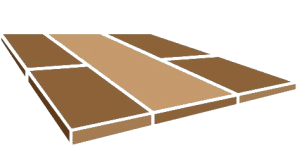Permeable paving grids serve as an indispensable stormwater management tool by allowing water to freely flow between the pavement and reduce runoff volume. They look good and are just as durable as conventional pavements made of concrete and gravel.
There are many types of porous paving systems, including interlocking concrete grids, permeable asphalt and concrete pavers, and flexible pavement structure with reinforced plastic.
Contents
What Makes Permeable Pavement Systems Effective?
Permeable systems are usually made from concrete or clay brick with joints. These joints are filled with crushed aggregate composed of marble, granite, or quartz. The unique design is porous so water can enter beneath the surface and make its way to the ground.
While traditional systems retain water and allow it to run off into drainage systems, permeable systems mimic how natural materials absorbs water. The type of permeable paving system and the material will influence the rate at which the water seeps underground.
What exactly happens to the water depends on the kind of drainage system you use – the water makes its way back into the groundwater table or is slowly released into the drainage system. In all cases, this will reduce the overflow of water due to naturally occurring events such as snowmelt and heavy rainfall.
Permeable paving systems have various features that might make them superior to traditional pavers, including:
- Higher thickness
- The use of joints that allow water to permeate through
- Does not make use of sand because it can stop the filtration process
- Ideal for use in driveways, larger parking lots, and even roadways
The Importance of Proper Installation
A professional paver contractor should install permeable pavers because they’re different than traditional paving systems. For example, permeable pavers are about 20mm thicker than non-permeable pavers. Their joints may also vary from 3mm to 12mm wide, depending on the amount of water that is to be managed. Moreover, permeable systems do not make use of sand to allow water to pass through.
During installation, these subtle nuances should be handled by a specialist paver contractor who knows how to work with the new materials. Proper installation requires access to specialized equipment and preparing the sub-base.
It May Not be Suitable for all Soil Types
A key disadvantage of permeable pavers is that they may not be ideal for use across all soil types. For instance, soils filled with clay don’t drain well and, as a consequence, don’t provide a porous base for water to enter into.
Extreme Durability and other Advantages
There is a common misunderstanding that suggests permeable pavers aren’t very durable. However, most permeable systems can be used in various harsh climates and heavy-traffic roads. Permeable systems have very high compressive strength capabilities at a minimum of 8,000 psi.
Thanks to the use of open aggregates, they also tend to be more flexible and can easily withstand multiple freeze-thaw cycles.
Finally, permeable paving systems are very similar to concrete in terms of maintenance. The only requirement is to vacuum the joints between the pavers to clear out any debris that makes its way in. Even a leaf blower will do just fine for most residential installations. They have high life cycles and save owners a large chunk of change since there is no need to invest in a retention pond for stormwater management.




